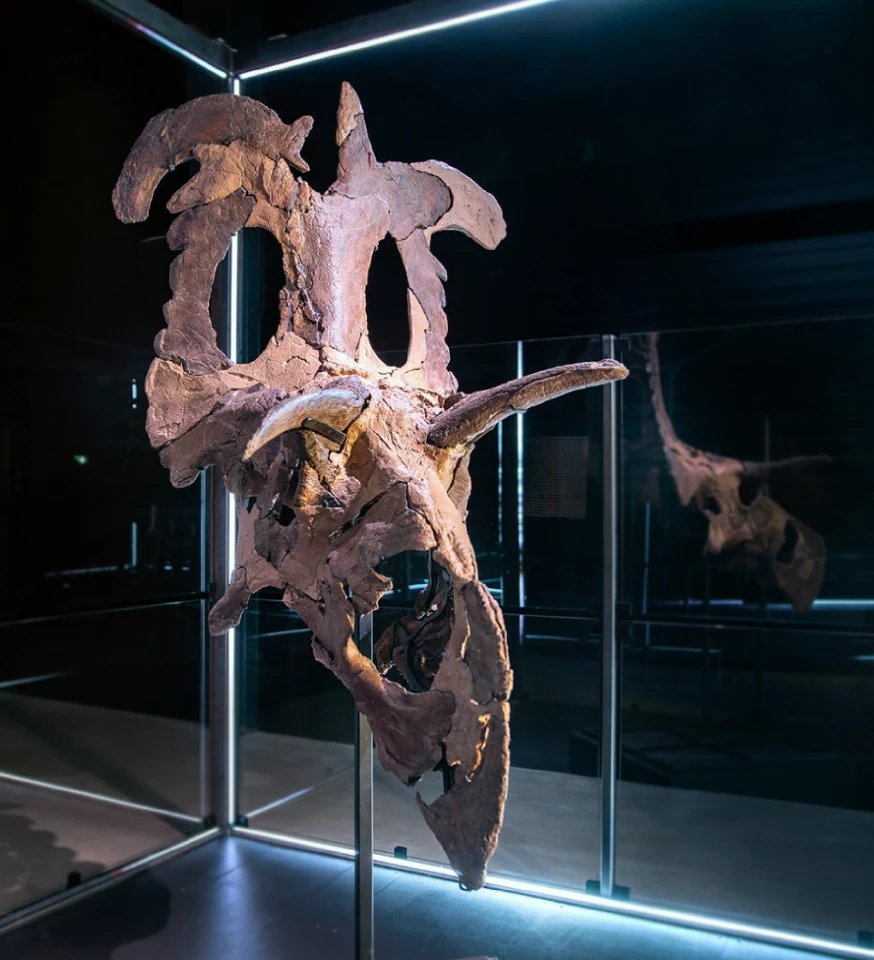Paleontologists uncovered the dinosaur’s fragmented skull in 2019 in northern Montana, two miles (3.2 km) south of the US-Canada border. It wasn’t until they started piecing the skull together that they realized it was a new type of dinosaur belonging to a larger group called ceratopsians, beaked, horned dinosaurs that ate plants.
“This new dinosaur pushed the envelope on bizarre ceratopsian headgear, sporting the largest frill horns ever seen in a ceratopsian,” said Joseph Sertich, an affiliate professor at Colorado State University and co-lead author of a published paper about the find. “These skull ornaments are one of the keys to unlocking horned dinosaur diversity and demonstrate that evolutionary selection for showy displays contributed to the dizzying richness of Cretaceous ecosystems.”

The dinosaur possesses several unique features: the absence of a nose horn, a pair of huge, curving blade-like horns on the back of the frill (the largest seen on a horned dinosaur), and an asymmetric spike in the middle of the frill. Sertich and University of Utah professor Mark Loewen, the paper’s other lead author, chose the dinosaur’s name partly because of its impressive headgear: Lokiceratops rangiformis.
If you think the name sounds familiar, you’re right. The dinosaur was named after Loki, the Norse god of mischief, trickery and deception, and roughly translates to ‘Loki’s horned face that looks like a caribou.'
“The dinosaur now has a permanent home in Denmark, so we went with a Norse god, and in the end, doesn’t it just really look like Loki with the curving blades?” Loewen said, referring to the horned helmet worn by the Marvel Cinematic Universe version of Loki.
Lokiceratops is estimated to have been 22 feet (6.7 m) long, weighed 11,000 lb (5 metric tonnes), and roamed the island continent of Laramidia – what is now the western part of North America – more than 78 million years ago, at least 12 million years before Triceratops. It’s the fourth centrosaurine, or horned dinosaur, and the fifth overall identified in the northern Montana/southern Alberta, Canada region.

“Previously, paleontologists thought a maximum of two species of horned dinosaurs could coexist at the same place and time,” said Loewen. “Incredibly, we have identified five living together at the same time. The skull of Lokiceratops rangiformis is dramatically different from the other four animals it lived alongside.”
The researchers say that the discovery of Lokiceratops alongside the other four specimens provides evidence that the species evolved rapidly within a small area.
“It’s unheard-of diversity to find five living together, similar to what you would see on the plains of East Africa today with different horned ungulates [large mammals with hooves],” Sertich said.
The more complete ‘family tree’ that’s been created with the addition of Lokiceratops probably means we’ve underestimated dinosaur diversity. The evolution of these ceratopsians was likely driven by sexual selection, meaning that mates were repeatedly drawn to certain traits – such as the details seen on Lokiceratops’ frill – and, over time, the traits were passed down.

“Lokiceratops helps us understand that we are only scratching the surface when it comes to the diversity and relationships within the family tree of horned dinosaurs,” said Loewen.
While the original fossil resides at the Museum of Evolution in Maribo, Denmark, a replica is displayed at the Natural History Museum of Utah (NHMU). In the video below, Loewen describes the discovery of Lokiceratops rangiformis and its significance.
The study was published in the journal PeerJ.
Sources: Colorado State University, Natural History Museum of Utah, EurekAlert!








